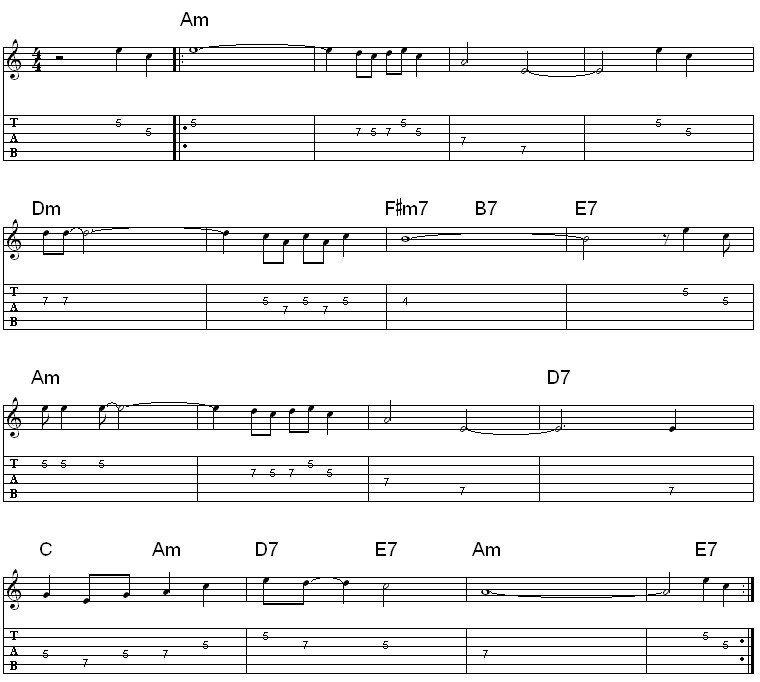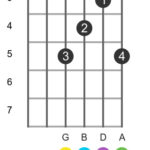“Summertime,” composed by George Gershwin, is a timeless classic beloved by musicians and listeners alike. Its haunting melody and rich harmonies make it a favorite for guitarists, especially during the warmer months. If you’re looking to expand your repertoire with beautiful jazz-infused pieces, learning the guitar chords for “Summertime” is a fantastic starting point. This lesson, inspired by the arrangement of the incredible jazz guitarist Emily Remler, will guide you through playing “Summertime” on guitar, covering the melody, chords, and even some soloing tips to get you improvising over this iconic tune.
Unpacking the Summertime Melody on Guitar
Let’s begin by exploring the core melody of “Summertime” and its foundational chords. Understanding the melody is crucial as it’s the heart of the song. Here’s the melody written out for guitar, positioned in an easily accessible and playable area of the fretboard.
 Summertime Melody for Guitar
Summertime Melody for Guitar
Alt text: Summertime melody sheet music for guitar in Am, showing notes on the fretboard for easy playing.
This melody arrangement sits comfortably within the first A minor pentatonic shape at the 5th fret, making it relatively straightforward to learn and memorize. Notice that the underlying chords for “Summertime” are not overly complex, which is part of its broad appeal.
A great practice approach is to master the melody first. Sing it while you play it on your guitar. This will help internalize the tune. For rhythm practice, if you have a looper pedal, try recording a simple chord progression to play the melody over. This will help you hear how the melody and harmony interact.
Crafting a Solo Guitar Arrangement of Summertime
“Summertime” lends itself beautifully to solo guitar arrangements. The song naturally has pauses and spaces that allow for chordal insertions, which opens up possibilities for harmonic exploration. We can take inspiration from Emily Remler’s approach to creating a solo guitar version by incorporating chords within the melody. Here’s a solo guitar arrangement that builds upon this concept, utilizing Emily’s chord changes and rhythmic feel as a foundation.
Alt text: Summertime solo guitar arrangement sheet music showing melody with added chord voicings for a rich harmonic texture.
This arrangement demonstrates how you can weave chords into the melodic structure of “Summertime”, creating a richer, more harmonically complete sound suitable for solo guitar performance.
Essential Guitar Chords for Summertime
The beauty of “Summertime” also lies in its elegant chord progression. The chords used are generally familiar and accessible to most guitarists, making it a rewarding piece to learn. Let’s break down the essential guitar chords you’ll need to play “Summertime”:
-
Am7 – A minor seventh chord, the starting point and home base of the song.
-
Bm7 – B minor seventh chord, creating a slight tension and movement away from the Am7.
-
Dm7 – D minor seventh chord, a smooth and natural progression within the key of A minor.
-
Em7 – E minor seventh chord, building towards the dominant chord and resolution.
Alt text: Em7 chord diagram for guitar, illustrating finger placement on the fretboard for E minor seventh chord.
-
D9 – D dominant ninth chord, adding a jazzy and sophisticated flavor.
-
E7#9 – E dominant 7 sharp 9 chord, a classic jazz voicing that injects a bluesy and dissonant element.
Alt text: E7 sharp 9 chord diagram for guitar, showing finger positions for the dominant 7 sharp 9 chord on E.
- C (no root) – A C major chord voiced without the root note, often played as a C/E, creating a smooth bass line movement.
Practice each of these chords individually to ensure clean and clear execution. Then, work on smoothly transitioning between them. Understanding the function of each chord within the progression will deepen your musical understanding and performance.
Soloing Over Summertime: Tips and Techniques
While playing the chord melody arrangement is satisfying, improvising and soloing over the “Summertime” chord changes opens up a new dimension of musical expression. Here are some starting points to guide you in your soloing journey:
Start with Chord Tones
A fundamental approach to jazz soloing is to begin by focusing on chord tones – the notes that make up each chord. Prioritize the Major or Minor 3rd and 7th of each chord as target notes in your solos. Try creating simple melodic lines using these chord tones to connect the chords. Experiment with playing chord tones as single notes and in octaves for varied textures.
Chromaticism for Color
Once you’re comfortable with chord tones, introduce chromatic notes as passing or connecting notes. Chromaticism adds color and sophistication to your lines and is a hallmark of jazz improvisation. Even subtle chromatic additions can make your solo sound more nuanced and jazzy.
Scales as Melodic Resources
Scales provide a broader palette of notes for soloing. For “Summertime,” you can effectively use A minor pentatonic and C major scales over a significant portion of the chord progression.
Alt text: A minor pentatonic scale shape diagram for guitar, illustrating the first position of the A minor pentatonic scale.
These scales offer a solid foundation for constructing melodic phrases. While they may not perfectly fit every chord, they provide a great starting point for exploring melodic ideas.
Conquering the E7#9 Chord
The E7#9 chord presents a unique soloing challenge. A few approaches can be used:
- A Major Pentatonic or A Major Scale: Treat the E7#9 as a V chord in A and use A major pentatonic or A major scale. This simplifies the approach and works surprisingly well.
Alt text: A major pentatonic scale shape diagram for guitar, showing the first position of the A major pentatonic scale on the fretboard.
-
F Jazz Minor Scale: Following Emily Remler’s method, play a Jazz minor scale up a half step from the root of the E7#9. This means using the F Jazz minor scale. This creates a more outside and jazzy sound.
-
A Chromatic Scale: For a very adventurous and modern sound, you can even use an A chromatic scale over the E7#9.
Alt text: A chromatic scale shape diagram for guitar, depicting a chromatic scale pattern starting on A.
Experiment with these different scales and approaches to discover what sounds best to your ear and fits your improvisational style.
Putting It All Together: Practice and Performance
Learning “Summertime” on guitar, from chords to soloing, is a rewarding journey. Start by mastering the melody, ensuring each note is clear and expressive. Then, tackle the chords separately, focusing on smooth transitions. Gradually combine the melody and chords to create the solo guitar arrangement.
Once comfortable with the arrangement, delve into soloing. Record the chord changes and use it as a backing track to practice your improvisational ideas. Remember, learning to play “Summertime” well takes time and dedication, but the musical payoff is immense. It’s a fantastic piece to add to your repertoire, perfect for summertime playing and beyond.

